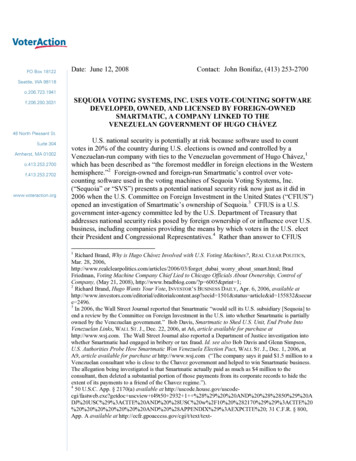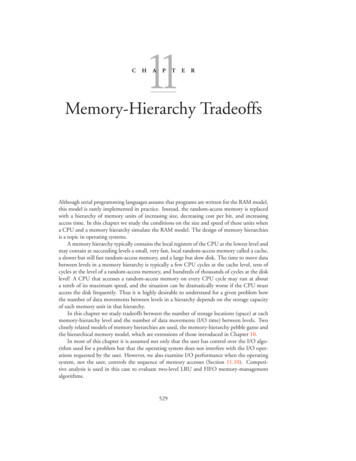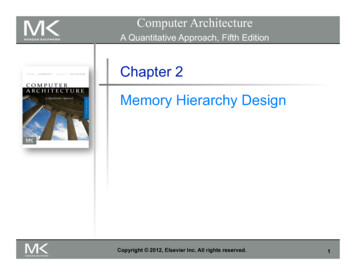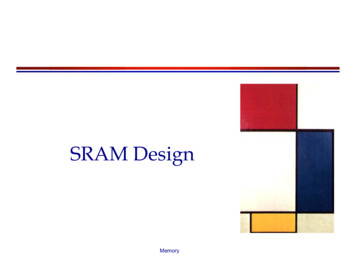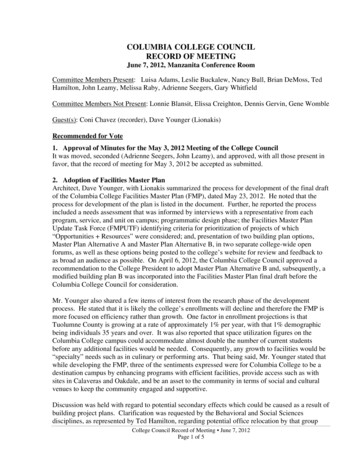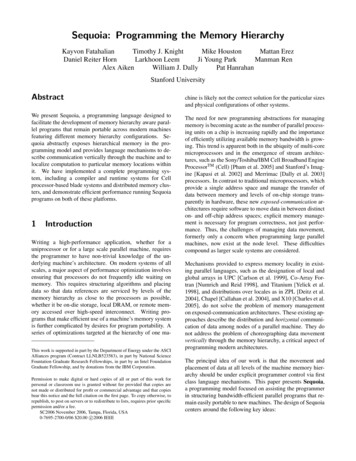
Transcription
Sequoia: Programming the Memory HierarchyKayvon FatahalianTimothy J. KnightMike HoustonMattan ErezDaniel Reiter HornLarkhoon LeemJi Young ParkManman RenAlex AikenWilliam J. DallyPat HanrahanStanford UniversityAbstractchine is likely not the correct solution for the particular sizesand physical configurations of other systems.We present Sequoia, a programming language designed tofacilitate the development of memory hierarchy aware parallel programs that remain portable across modern machinesfeaturing different memory hierarchy configurations. Sequoia abstractly exposes hierarchical memory in the programming model and provides language mechanisms to describe communication vertically through the machine and tolocalize computation to particular memory locations withinit. We have implemented a complete programming system, including a compiler and runtime systems for Cellprocessor-based blade systems and distributed memory clusters, and demonstrate efficient performance running Sequoiaprograms on both of these platforms.The need for new programming abstractions for managingmemory is becoming acute as the number of parallel processing units on a chip is increasing rapidly and the importanceof efficiently utilizing available memory bandwidth is growing. This trend is apparent both in the ubiquity of multi-coremicroprocessors and in the emergence of stream architectures, such as the Sony/Toshiba/IBM Cell Broadband EngineProcessorTM (Cell) [Pham et al. 2005] and Stanford’s Imagine [Kapasi et al. 2002] and Merrimac [Dally et al. 2003]processors. In contrast to traditional microprocessors, whichprovide a single address space and manage the transfer ofdata between memory and levels of on-chip storage transparently in hardware, these new exposed-communication architectures require software to move data in between distincton- and off-chip address spaces; explicit memory management is necessary for program correctness, not just performance. Thus, the challenges of managing data movement,formerly only a concern when programming large parallelmachines, now exist at the node level. These difficultiescompound as larger scale systems are considered.1IntroductionWriting a high-performance application, whether for auniprocessor or for a large scale parallel machine, requiresthe programmer to have non-trivial knowledge of the underlying machine’s architecture. On modern systems of allscales, a major aspect of performance optimization involvesensuring that processors do not frequently idle waiting onmemory. This requires structuring algorithms and placingdata so that data references are serviced by levels of thememory hierarchy as close to the processors as possible,whether it be on-die storage, local DRAM, or remote memory accessed over high-speed interconnect. Writing programs that make efficient use of a machine’s memory systemis further complicated by desires for program portability. Aseries of optimizations targeted at the hierarchy of one maThis work is supported in part by the Department of Energy under the ASCIAlliances program (Contract LLNLB523583), in part by National ScienceFountation Graduate Research Fellowships, in part by an Intel FoundationGraduate Fellowship, and by donations from the IBM Corporation.Permission to make digital or hard copies of all or part of this work forpersonal or classroom use is granted without fee provided that copies arenot made or distributed for profit or commercial advantage and that copiesbear this notice and the full citation on the first page. To copy otherwise, torepublish, to post on servers or to redistribute to lists, requires prior specificpermission and/or a fee.SC2006 November 2006, Tampa, Florida, USA0-7695-2700-0/06 20.00 c 2006 IEEEMechanisms provided to express memory locality in existing parallel languages, such as the designation of local andglobal arrays in UPC [Carlson et al. 1999], Co-Array Fortran [Numrich and Reid 1998], and Titanium [Yelick et al.1998], and distributions over locales as in ZPL [Deitz et al.2004], Chapel [Callahan et al. 2004], and X10 [Charles et al.2005], do not solve the problem of memory managementon exposed-communication architectures. These existing approaches describe the distribution and horizontal communication of data among nodes of a parallel machine. They donot address the problem of choreographing data movementvertically through the memory hierarchy, a critical aspect ofprogramming modern architectures.The principal idea of our work is that the movement andplacement of data at all levels of the machine memory hierarchy should be under explicit programmer control via firstclass language mechanisms. This paper presents Sequoia,a programming model focused on assisting the programmerin structuring bandwidth-efficient parallel programs that remain easily portable to new machines. The design of Sequoiacenters around the following key ideas:
Task: matrix multiplicationof 1024x1024 matricesTask:128x128matrix multTask:32x32matrix multTask:128x128matrix multTask:128x128matrix mult 512subtasks Task:128x128matrix multTask:Task: 6432x3232x32subtasks matrix multmatrix multFigure 1: Multiplication of 1024x1024 matrices structuredas a hierarchy of independent tasks performing smaller multiplications. We introduce the notion of hierarchical memory directly into our programming model to gain both portability and performance. Sequoia programs run on machines that are abstracted as trees of distinct memorymodules and describe how data is moved and where itresides in a machine’s memory hierarchy. We use tasks as abstractions of self-contained units ofcomputation that include descriptions of key information such as communication and working sets. Tasksisolate each computation in its own local address spaceand also express parallelism. To enable portability, we maintain a strict separationbetween generic algorithmic expression and machinespecific optimization. To minimize the impact of thisseparation on performance, details of the machinespecific mapping of an algorithm are exposed to programmer control.Sequoia takes a pragmatic approach to portable parallel programming by providing a limited set of abstractions that canbe implemented efficiently and controlled directly by theprogrammer. While the compiler implementation describedin this paper does not make heavy use of automatic analysis, we have taken care to ensure that Sequoia programs arewritten within a framework that is amenable to the use ofadvanced compiler technology.Details of Sequoia programming are discussed in Sections2 through 4. Section 5 describes our implementation of aSequoia language compiler and associated runtime systemsfor Cell-based workstations and for clusters of PCs. Section6 discusses the performance obtained by running initial Sequoia applications on both of these parallel platforms.2MainmemoryMainmemoryHierarchical MemoryOn modern systems featuring deep memory hierarchies andmany parallel processing units, breaking large computationsLS LS LS LS LS LS LS LSALUs ALUs ALUs ALUs ALUs ALUs ALUs ALUsCELL processorL2 cacheL2 cacheL1 cacheL1 cacheALUsALUsDual-CPU workstationFigure 2: A Cell workstation (left) is modeled as a tree containing nodes corresponding to main system memory andeach of the processor’s software-managed local stores. Arepresentation of a dual-CPU workstation is shown at right.into smaller operations is essential to achieving good performance because it exposes parallelism and results in efficientexecution on datasets stored local to processing elements.Common examples of this optimization technique includeblocking to increase cache locality and problem decomposition to minimize network communication in MPI programsfor clusters. In Figure 1 we illustrate the hierarchical structure of a computation to perform blocked matrix multiplication, an example we revisit throughout much of this paper. In this algorithm, which features nested parallelism anda high degree of hierarchical data locality, parallel evaluation of submatrix multiplications is performed to computethe product of two large matrices.Sequoia requires such hierarchical organization in programs,borrowing from the idea of space-limited procedures [Alpernet al. 1995], a programming methodology proposed to encourage hierarchy-aware, parallel divide-and-conquer programs. Space-limited procedures require each function in acall chain to accept arguments occupying significantly lessstorage than those of the calling function. Sequoia tasks(Section 3) generalize and concretize the concept of a spacelimited procedure into a central construct used to expresscommunication and parallelism and enhance the portabilityof algorithms. We have implemented a complete programming system around this abstraction, including a compilerand runtime systems for Cell and distributed memory clusters.Writing Sequoia programs involves abstractly describing hierarchies of tasks (as in Figure 1) and then mapping thesehierarchies to the memory system of a target machine. Sequoia requires the programmer to reason about a parallel machine as a tree of distinct memory modules, a representationthat extends the Parallel Memory Hierarchy (PMH) model ofAlpern et al. [1993]. Data transfer between memory modulesis conducted via (potentially asynchronous) block transfers.Program logic describes the transfers of data at all levels, butcomputational kernels are constrained to operate upon datalocated within leaf nodes of the machine tree. The abstractrepresentation of a system containing a Cell processor (at
CPUCPUL1L1L2L2NodememoryNodememoryVirtual level:Aggregate cluster memoryNodememory.NodememoryL2 cache.L2 cacheL1 cache.L1 L1CPUL1CPUCluster of uniprocessor PCsTree representation ofa cluster of PCsFigure 3: The point-to-point links connecting PCs in a cluster are modeled as a virtual node in the tree representation ofthe machine.left in Figure 2) contains nodes corresponding to main system memory and each of the 256KB software-managed localstores (LSes) located within the chip’s synergistic processingunits (SPEs). At right in Figure 2, a model of a dual-CPUworkstation contains nodes representing the memory sharedbetween the two CPU’s as well as the L1 and L2 cacheson each processor. Sequoia permits a machine to be modeled with detail commensurate with the programmer’s needs.A representation may include modules corresponding to allphysical levels of the machine memory hierarchy, or it mayomit levels of the physical hierarchy that need not be considered for software correctness or performance optimization.Establishing an abstract notion of hierarchical memory iscentral to the Sequoia programming model. Sequoia codedoes not make explicit reference to particular machine hierarchy levels and it remains oblivious to the mechanisms usedto move data between memory modules. For example, communication described in Sequoia may be implemented using a cache prefetch instruction, a DMA transfer, or an MPImessage depending on the requirements of the target architecture. Supplying constructs to describe the movement ofdata throughout a machine while avoiding any reference tothe specific mechanisms with which transfers are performedis essential to ensuring the portability of Sequoia programswhile retaining the performance benefits of explicit communication.As with the PMH model, our decision to represent machinesas trees is motivated by the desire to maintain portabilitywhile minimizing programming complexity. A program thatperforms direct communication between sibling memories,such as a program written using MPI for a cluster, is not directly portable to a parallel platform where such channels donot exist. Because many machines have complex non-treetopologies we allow our tree abstraction to include virtuallevels that do not correspond to any single physical machinememory. For example, it is not practical to expect the nodesin a cluster of workstations to communicate only via globalstorage provided by networked disk. As shown in Figure3, our model represents a cluster as a tree rooted by a virtual level corresponding to the aggregation of all workstation memories. The virtual level constitutes a unique address space distinct from any node memory. Transferringdata from this global address space into the child modules associated with individual cluster workstations results in communication over the cluster interconnect. The virtual levelmechanism allows us to generalize the tree abstraction formodeling vertical communication to encapsulate horizontalinter-node communication as well.3Sequoia DesignThe principal construct of the Sequoia programming modelis a task: a side-effect free function with call-by-value-resultparameter passing semantics. Tasks provide for the expression of: Explicit Communication and Locality. Communication of data through the memory hierarchy is expressedby passing arguments to tasks. Calling tasks is the onlymeans of describing data movement in Sequoia. Isolation and Parallelism. Tasks operate entirelywithin their own private address space and have nomechanism to communicate with other tasks other thanby calling subtasks and returning to a parent task. Taskisolation facilitates portable concurrent programming. Algorithmic Variants. Sequoia allows the programmer to provide multiple implementations of a task andto specify which implementation to use based on thecontext in which the task is called. Parameterization. Tasks are expressed in a parameterized form to preserve independence from the constraintsof any particular machine. Parameter values are chosento tailor task execution to a specific hierarchy level of atarget machine.This collection of properties allows programs written usingtasks to be portable across machines without sacrificing theability to tune for performance.3.1Explicit Communication And LocalityA Sequoia implementation of blocked matrix multiplicationis given in Figure 4. The matmul task multiplies M x P inputmatrix A by P x N input matrix B, accumulating the resultsinto M x N matrix C (C is a read-modify-write argument tothe task). The task partitions the input matrices into blocks
123456789void task matmul :: inner ( infloat A [ M ][ P ] ,infloat B [ P ][ N ] ,inout float C [ M ][ N ] ){// Tunable p a r a m e t e r s specify the size// of s u b b l o c k s of A , B , and C .tunable int U ;tunable int X ;tunable int V ;Working set of matmul task (calling / P a r t i t i o n m a t r i c e s into sets of blocks// using regular 2 D c h o p p i n g .blkset Ablks rchop (A , U , X );blkset Bblks rchop (B , X , V );blkset Cblks rchop (C , U , V 3536Working set of matmul subtask:// Compute all blocks of C in p a r a l l e l .mappar ( int i 0 to M /U , int j 0 to N / V ) {mapreduce ( int k 0 to P / X ) {// Invoke the matmul task r e c u r s i v e l y// on the s u b b l o c k s of A , B , and C .matmul ( Ablks [ i ][ k ] , Bblks [ k ][ j ] , Cblks [ i ][ j ]);}}17void task matmul :: leaf ( infloat A [ M ][ P ] ,infloat B [ P ][ N ] ,inout float C [ M ][ N ] ){// Compute matrix product d i r e c t l yfor ( int i 0; i M ; i )for ( int j 0; j N ; j )for ( int k 0; k P ; k )C [ i ][ j ] A [ i ][ k ] * B [ k ][ j ];}Figure 4:Dense matrix multiplication in Sequoia.matmul::inner and matmul::leaf are variants of thematmul task.(lines 13–15) and iterates over submatrix multiplications performed on these blocks (lines 18–24). An explanation of theSequoia constructs used to perform these operations is provided in the following subsections.Defining tasks expresses both locality and communicationin a program. While a task executes, its entire working set(the collection of all data the task can reference) must remainresident in a single node of the abstract machine tree. As aresult, a task is said to run at a specific location in the machine. In Figure 4, the matrices A, B, and C constitute theworking set of the matmul task. Pointers and references arenot permitted within a task and therefore a task’s working setis manifest in its definition.Notice that the implementation of matmul makes a recursive call in line 22, providing subblocks of its input matrices as arguments in the call. To encapsulate communication,Sequoia tasks use call-by-value-result (CBVR) [Aho et al.1986] parameter passing semantics. Each task executes inthe isolation of its own private address space (see Subsection3.2) and upon task call, input data from the calling task’s address space is copied into that of the callee. Output argumentdata is copied back into the caller’s address space when thecall returns. The change in address space induced by the recursive matmul call is illustrated in Figure 5. The block ofCBMPNN(0,0)(0,0)(0,0)APBMCFigure 5: The matmul::inner variant calls subtasks thatperform submatrix multiplications. Blocks of the matricesA, B, and C are passed as arguments to these subtasks andappear as matrices in the address space of a subtask.size U x X of matrix A from the calling task’s address spaceappears as a similarly sized array in the address space of thecalled subtask. CBVR is not common in modern languages,but we observe that for execution on machines where data istransferred between distinct physical memories under software control, CBVR is a natural parameter passing semantics.The mapping of a Sequoia program dictates whether a calleetask executes within the same memory module as its calling task or is assigned to a child (often smaller) memorymodule closer to a compute processor. In the latter case,the subtask’s working set must be transferred between thetwo memory modules upon task call/return. Thus, the call/return of a subtask implies that data movement through themachine hierarchy might occur. Explicitly defining workingsets and limiting communication to CBVR parameter passing allows for efficient implementation via hardware blocktransfer mechanisms and permits early initiation of transferswhen arguments are known in advance.3.2Isolation and ParallelismThe granularity of parallelism in Sequoia is the task and parallel execution results from calling concurrent tasks. Lines18–24 of Figure 4 describe iteration over submatrix multiplications that produces a collection of parallel subtasks. (Thei and j dimensions of the iteration space may be executed inparallel while the innermost dimension defines a reduction).In Sequoia, each of these subtasks executes in isolation, akey property introduced to increase code portability and performance.
Sequoia Blocking PrimitivesblksetAn opaque Sequoia object representing a collection of array blocks.rchop(A, len0, len1, .)Generates a blkset containing non-overlapping blocks that tile the multidimensional array A. Each block is multi-dimensional with size len0 len1 . . .rchop(A, rchop t(offset0, len0, stride0), .)Generalized form of rchop that generates blocksets containing potentiallyoverlapping blocks. The starting array offset, block size, and stride betweenblocks is specified for every dimension of the source array.ichop(A, Starts, Ends, N)Generates a set of N irregularly-sized blocks from array A. Block start andend indices are given by elements in the length-N integer arrays Startsand Ends.gather(A, IdxBlkset)Generates a set of blocks by gathering elements from source array A usingthe indices provided in the blocks of IdxBlkset. The resulting blksethas the same number and size of blocks as IdxBlkset.Sequoia Mapping Primitivesmappar(i i0 to iM, j j0 to jN .) {.}A multi-dimensional for-all loop containing only a subtask call in the loopbody. The task is mapped in parallel onto a collection of blocks.mapseq(i i0 to iM, j j0 to jN .) {.}A multi-dimensional loop containing only a subtask call in the loop body.The task is mapped in sequentially onto a collection of blocks.mapreduce(i i0 to iM, j j0 to jN .) {.}Maps a task onto a collection of blocks, performing a reduction on at leastone argument to the task. To support parallel tree reductions, an additionalcombiner subtask is required.Table 1: Sequoia mapping and blocking primitivesIsolation of task address spaces implies that no constraintsexist on whether a subtask must execute within the samelevel of the memory hierarchy as its calling task. Additionally, Sequoia tasks have no means of communicating withother tasks executing concurrently on a machine. Althoughthe implementation of matmul results in the execution ofmany parallel tasks, these concurrent tasks do not function ascooperating threads. The lack of shared state among tasks allows parallel tasks to be executed simultaneously using multiple execution units or sequentially on a single processor.Task isolation simplifies parallel programming by obviatingthe need for synchronization or locking constructs requiredby cooperating threads. Sequoia language semantics requirethat output arguments passed to concurrent subtasks do notalias in the calling task’s address space. We currently rely onthe programmer to ensure this condition holds.3.3Task DecompositionWe now introduce Sequoia’s array blocking and task mapping constructs: first-class primitives available to describeportable task decomposition.In Sequoia a subset of an array’s elements is referred to asan array block. For example, A[0:10] is the block corresponding to the first 10 elements of the array A. The matmultask uses the rchop (regular chop) blocking function to de-scribe a regular 2D partitioning of its input matrices. In line13, rchop is used to divide the matrix A into a set of blockseach U x X in size. This collection is returned in the formof an opaque Sequoia object referred to as a blockset. Sequoia provides a family of blocking functions (see Table 1)to facilitate decompositions that range from the simplicity ofrchop to the irregularity of arbitrary array gathers.After defining blocksets using rchop, matmul iterates overthe blocks, recursively calling itself on blocks selected fromAblks, Bblks, and Cblks in each iteration. As introducedin Subsection 3.2, the mappar construct designates parallel iteration, implying concurrency among subtasks but notasynchronous execution between calling and child tasks. Alliterations of a mappar or mapreduce must complete beforecontrol returns to the calling task.Imperative C-style control-flow is permitted in tasks, but useof blocking and mapping primitives is encouraged to facilitate key optimizations performed by the Sequoia compilerand runtime system. All applications presented in Section 6use only mapping primitives to describe iteration. A complete listing of Sequoia blocking and mapping constructs isgiven in Table 1.3.4Task VariantsFigure 4 contains two implementations of the matmul task,matmul::inner and matmul::leaf. Each implementation is referred to as a variant of the task and is namedusing the syntax taskname::variantname. The variantmatmul::leaf serves as the base case of the recursive matrix multiplication algorithm. Notice that the Sequoia codeto recursively call matmul gives no indication of when thebase case should be invoked. This decision is made as partof the machine-specific mapping of the algorithm (Section4).Inner tasks, such as matmul::inner, are tasks that call subtasks. Notice that matmul::inner does not access elementsof its array arguments directly and only passes blocks of thearrays to subtasks. Since a target architecture may not support direct processor access to data at certain hierarchy levels, to ensure code portability, the Sequoia language does notpermit inner tasks to directly perform computation on arrayelements. Instead, inner tasks use Sequoia’s mapping andblocking primitives (Section 3.3) to structure computationinto subtasks. Ultimately, this decomposition yields computations whose working sets fit in leaf memories directlyaccessible by processing units. An inner task definition isnot associated with any particular machine memory module;it may execute at any level of the memory hierarchy in whichits working set fits.Leaf tasks, such as matmul::leaf, do not call subtasks andoperate directly on working sets resident within leaf levels of
matmul cluster instmatmul::innermatmul::leafParameterized tasksmatmul mainmem instvariant innerU 128 X 64 V 128Main memorymatmul LS instvariant innerU 1024 X 1024 V 1024Cluster levelmatmul node instvariant innerU 128 X 128 V 128Node levelCell task instancesinstancenamevariantruns at}{ matmul LS inst matmul :: leaf LS levelvariant innerU 32 X 32 V 32L2 levelmatmul L1 instvariant leafmatmul mainmem instmatmul :: innermain memorymatmul LS instU 128 , X 64 , V 128instancenamevariantruns atcallstunable}instancenamevariantruns atcallstunable}instancenametaskruns atcallstunable}instancenametaskruns at}{ { { matmul cluster instmatmul :: innercluster levelmatmul node instU 1024 , X 1024 , V 1024matmul node instmatmul :: innernode levelmatmul L2 instU 128 , X 128 , V 128matmul L2 instmatmul :: innerL2 cache levelmatmul L1 instU 32 , X 32 , V 32{ matmul L1 inst matmul :: leaf L1 cache levelL1 levelCluster task instancesFigure 6: The call graph for the parameterized matmul taskis shown at top left. Specialization to Cell or to the clustermachine from Figure 3 generates instances of the task shownat bottom left and at right.the memory hierarchy. Direct multiplication of the input matrices is performed by matmul::leaf. In practice, Sequoialeaf tasks often wrap platform specific implementations ofcomputational kernels written in traditional languages, suchas C or Fortran.3.5{ matmul L2 instvariant leafLS levelinstancenametaskruns atcallstunable}Task ParameterizationTasks are written in parameterized form to allow for specialization to multiple target machines. Specialization is theprocess of creating instances of a task that are customized tooperate within, and are mapped to, specific levels of a target machine’s memory hierarchy. A task instance defines avariant to execute and an assignment of values to all variantparameters. The Sequoia compiler creates instances for eachof the various contexts in which a task is used. For example,to run the matmul task on Cell, the Sequoia compiler generates an instance employing the matmul::inner variant todecompose large matrices resident in main memory into LSsized submatrices. A second instance uses matmul::leafto perform the matrix multiplication inside each SPE. Ona cluster machine, one matmul instance partitions matricesdistributed across the cluster into submatrices that fit withinindividual nodes. Additional instances use matmul::innerto decompose these datasets further into L2- and then L1sized submatrices. While parameterized tasks do not namespecific variants when calling subtasks, specialized task instances make direct calls to other instances. The staticcall graph relating matmul’s parameterized task variants isshown at top left in Figure 6. Calls among the task instancesthat result from specialization to Cell and to a cluster are alsoshown in the figure. Notice that three of the cluster instances,Figure 7: Specification for mapping the matmul task to aCell machine (left) and a cluster machine (right).each mapped to a different location of the machine hierarchy,are created from the matmul::inner variant (each instancefeatures different argument sizes and parameter values).Task variants utilize two types of numeric parameters, arraysize parameters and tunable parameters. Array size parameters, such as M, N, and P defined in the matmul task variants, represent values dependent upon array argument sizesand may take on different values across calls to the same instance. Tunable parameters, such as the integers U, V, andX declared in matmul::inner (lines 7-9 of Figure 4), aredesignated using the tunable keyword. Tunable parametersremain unbound in Sequoia source code but are statically assigned values during task specialization. Once assigned, tunable parameters are treated as compile-time constants. Themost common use of tunable parameters, as illustrated by thematrix multiplication example, is to specify the size of arrayblocks passed as arguments to subtasks.Parameterization allows the decomposition strategy described by a task variant to be applied in a variety of contexts,making the task portable across machines and across levelsof the memory hierarchy within a single machine. The use oftunable and array size parameters and the support of multipletask variants is key to decoupling the expression of an algorithm from its mapping to an underlying machine. Tasks provide a framework for defining the application-specific spaceof decisions that must be made during the process of programtuning. In the following section, we describe the process oftuning and targeting Sequoia applications to a machine.4Task Specialization and TuningTasks are generic algorithms that must be specialized beforethey can be compiled into executable code. Mapping a hierarchy of tasks onto a hierarchical representation of memory
requires the creation of task instances for all machine levels.For each instance, a code variant to run must be selected, target instances for each call site must be chosen, and valuesfor tunable parameters must be provided.One approach to specialization is to rely upon the compiler toautomatically generate task instances for a target by means ofprogram analysis or a heuristic search through a pre-definedspace of possibilities. In Sequoia, the compiler is not required to perform this transformation. Instead we give theprogrammer complete control of the mapping and tuningphases of program development. A unique aspect of Sequoia is the task mapping specification that is created bythe programmer on a per-machine basis and is maintainedseparately from Sequoia source. The left half of Figure 7shows the information required to map matmul onto a Cel
Sequoia language compiler and associated runtime systems for Cell-based workstations and for clusters of PCs. Section 6 discusses the performance obtained by running initial Se-quoia applications on both of these parallel platforms. 2 Hierarchical Memory On modern systems featuring deep memory hierarchies and


